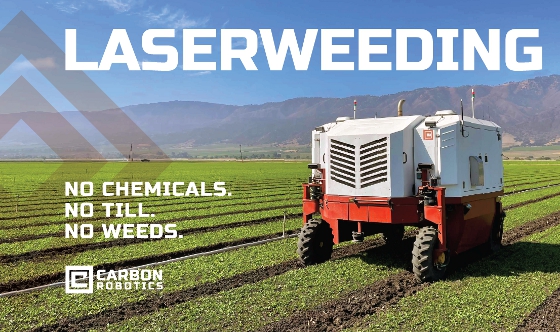 |
| September 28, 2021 | Volume 17 Issue 36 |
Designfax weekly eMagazine
Archives
Partners
Manufacturing Center
Product Spotlight
Modern Applications News
Metalworking Ideas For
Today's Job Shops
Tooling and Production
Strategies for large
metalworking plants
Laser-wielding autonomous robot zaps weeds for farmers: Take a look under the hood

The Autonomous Weeder from Carbon Robotics leverages robotics, artificial intelligence (AI), and laser technology to safely and effectively drive through crop fields to identify, target, and eliminate weeds. The terra Terminator on wheels -- which eliminates the use of chemical weed killers -- can zap up to 100,000 weeds an hour and cover up to 20 acres in a day.
It uses high-power lasers to eradicate weeds through thermal energy, without disturbing the soil. The diesel-driven automated robot allows farmers to use less herbicides and reduce labor to remove unwanted plants while improving the reliability and predictability of costs, crop yield, and more.
VIDEO: Meet the Autonomous Weeder from Carbon Robotics and see how its main systems work. [Credit: Carbon Robotics]
Since its founding in 2018, Seattle-based Carbon Robotics has worked closely with farmers to develop its technology, which supports effective and efficient weed elimination for both conventional and organic farmers. The robots have undergone beta testing on specialty-crop farms, working on fields with a variety of crops, including broccoli and onions. The new Autonomous Weeder is a third-gen machine.
The Autonomous Weeder runs day and night using its GPS and computer vision guidance system to stay within the bounds of the designated field, navigate furrows, and automatically turn around for the next row. Its high-resolution cameras scan the field, crops, and weeds in real time. A rugged, onboard computer uses machine learning to identify, in milliseconds, the difference between specific crops and invasive weeds -- all while rolling. Then, high-powered lasers target thermal endergy at each target weed's meristem (the critical region of cells capable of division and growth in plants) using eight simultaneously operating 150-W CO2 laser modules.
VIDEO: A look inside: Carbon Robotics laser scanner design. [Credit: Carbon Robotics]
Lasers leave the soil microbiology undisturbed, unlike tillage. The lack of herbicides and soil disruption paves the way for a regenerative approach, which leads to healthy crops and higher yields. Traditional chemicals used by farmers, such as herbicides, can deteriorate soil health and are tied to health problems in humans and other mammals. A laser-powered, autonomous weed management solution reduces or eliminates farmers' needs for herbicides.
Automated robots also enable farmers to reduce the highly variable cost of manual labor as well as reduce the use of other crop inputs such as fertilizers. Labor is often farmers' biggest cost, and crop inputs account for 28.2% of their total expenses, according to Successful Farming magazine. Reducing costs in both these areas is a huge benefit.
With 263 herbicide-resistant species of weeds across 71 countries, the company has seen a high demand for its products, securing a number of marquee growers and bookings that exceed $20 million.
Carbon Robotics has posted a series of videos that give an insider look into some of the Autonomous Weeder's components and systems. We hope you enjoy the short clips as much as we do.
VIDEO: A look inside: Carbon Robotics electrical system design. [Credit: Carbon Robotics]
VIDEO: A look inside: Carbon Robotics printed circuit boards. [Credit: Carbon Robotics]
VIDEO: A look inside: Carbon Robotics laser power meter. [Credit: Carbon Robotics]
VIDEO: A look inside: Carbon Robotics design and build path to the Autonomous Weeder. [Credit: Carbon Robotics]
"This is one of the most innovative and valuable technologies that I've seen as a farmer," said James Johnson of Carzalia Valley Produce, who has utilized Carbon Robotics' technology on his farm. "I expect the robots to go mainstream because of how effectively they address some of farming's most critical issues, including the overuse of chemicals, process efficiency, and labor. These robots work with a variety of crops, are autonomous and organic. The sky's the limit."
VIDEO: Carbon Robotics interview with James Johnson from Carzalia Valley Produce. [Credit: Carbon Robotics]
New models for the 2022 growing season are available for pre-order. Carbon Robotics offers a leasing option, which makes the robots more accessible to smaller farms with less acreage. The company says it will continue to explore new robot models and capabilities to help farmers improve efficiency and reliability across a variety of tasks.
On Sept. 1, 2021, Carbon Robotics announced it had secured $27 million in Series B financing from Anthos Capital, Ignition Partners, Fuse Venture Capital, Voyager Capital, Bolt, and Liquid2 Ventures to accelerate the company's growth.
Sources: Carbon Robotics, Successful Farming
Published September 2021
Rate this article
View our terms of use and privacy policy
